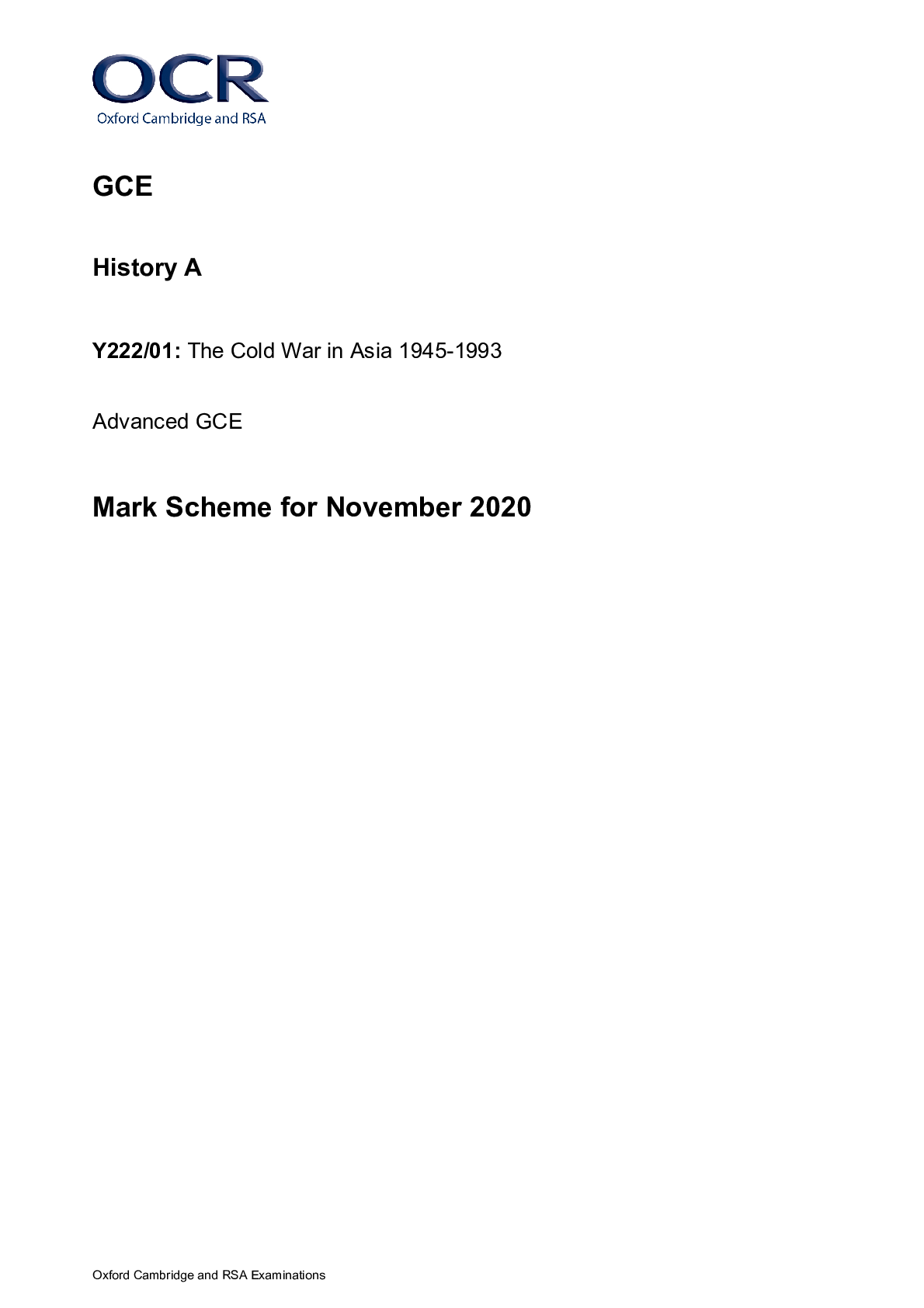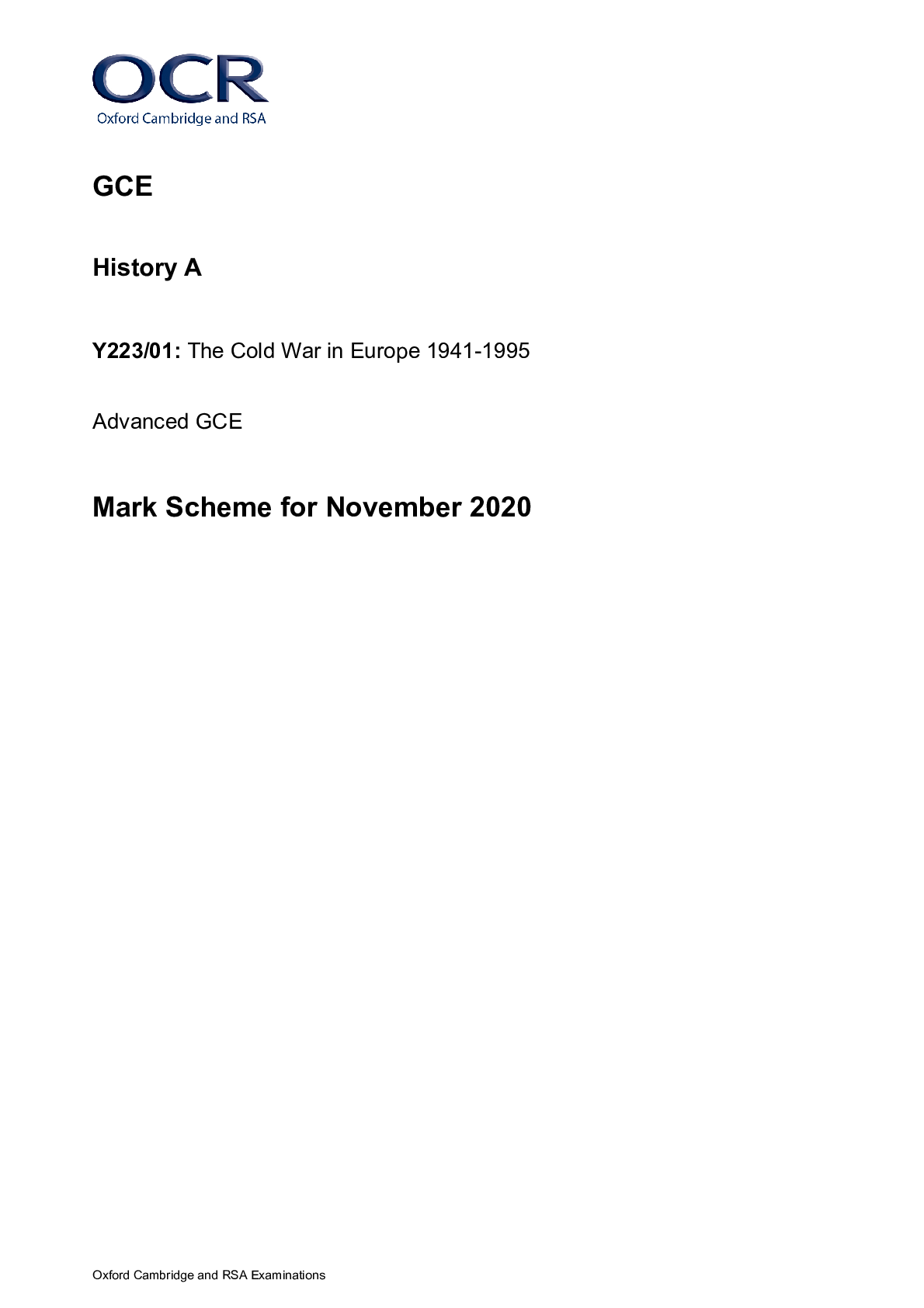History > AS Mark Scheme > GCE History A Y203/01: The Crusades and the Crusader States 1095-1192 Advanced GCE Mark Scheme for N (All)
GCE History A Y203/01: The Crusades and the Crusader States 1095-1192 Advanced GCE Mark Scheme for November 2020
Document Content and Description Below
Oxford Cambridge and RSA Examinations GCE History A Y203/01: The Crusades and the Crusader States 1095-1192 Advanced GCE Mark Scheme for November 2020Oxford Cambridge and RSA Examinations OCR (O... xford Cambridge and RSA) is a leading UK awarding body, providing a wide range of qualifications to meet the needs of candidates of all ages and abilities. OCR qualifications include AS/A Levels, Diplomas, GCSEs, Cambridge Nationals, Cambridge Technicals, Functional Skills, Key Skills, Entry Level qualifications, NVQs and vocational qualifications in areas such as IT, business, languages, teaching/training, administration and secretarial skills. It is also responsible for developing new specifications to meet national requirements and the needs of students and teachers. OCR is a not-for-profit organisation; any surplus made is invested back into the establishment to help towards the development of qualifications and support, which keep pace with the changing needs of today’s society. This mark scheme is published as an aid to teachers and students, to indicate the requirements of the examination. It shows the basis on which marks were awarded by examiners. It does not indicate the details of the discussions which took place at an examiners’ meeting before marking commenced. All examiners are instructed that alternative correct answers and unexpected approaches in candidates’ scripts must be given marks that fairly reflect the relevant knowledge and skills demonstrated. Mark schemes should be read in conjunction with the published question papers and the report on the examination. © OCR 2020Y203/01 Mark Scheme November 2020 2 Annotations Annotation Meaning of annotation Blank Page Highlight Off-page comment Assertion Analysis Evaluation Explanation Factor Illustrates/Describes Irrelevant, a significant amount of material that does not answer the question Judgement Knowledge and understanding Provenance Simple comment Unclear ViewY203/01 Mark Scheme November 2020 3 Subject Specific Marking Instructions MARK SCHEME Section A Questi on Answer Mar k Guidance 1a Which of the following was the more important cause of problems in the Crusader States in the twelfth century? (i) Problems of succession (ii) Internal rivalries. Explain your answer with reference to both (i) and (ii). • In arguing that (i) was of greater importance, answers may refer to the problems arising from the death of Baldwin II in 1131 leaving only daughters. • Answers may refer to the situation after the death of Baldwin III in 1163. • Answers may refer to problems in Antioch after the death of Bohemond II. • In arguing that (ii) was of greater importance, answers could refer to the struggles in Jerusalem between Fulk and Count Hugh of Jaffa. • Answers could refer to the rivalry between Melisende and her son. • Answers could consider the impact of the tension between the war and peace parties in the 1180s. 10 • No set answer is expected • Judgement must be supported by relevant and accurate material. • Only credit material relevant to question. • Answers may deal with each factor in turn, then compare them to reach a judgement, or take a continually comparative approach. Either approach is acceptable. • Knowledge must not be credited in isolation, it should only be credited where it is used as the basis for analysis and evaluation, in line with descriptions in the levels mark scheme.Y203/01 Mark Scheme November 2020 4 b* ‘Disunity among its leaders accounted for the failure of the Second Crusade.’ How far do you agree? • In arguing that disunity among the leaders was important: • Answers may refer to the tension between Louis VII and Raymond of Antioch. • Answers may argue that Odo of Deuil blamed Manuel for failing to provide enough aid. • Answer may argue that Conrad blamed the treachery of Baldwin III and the nobles of Jerusalem for misleading the crusaders. • Answers may argue that there were disputes over the promise to let Thierry of Flanders have Damascus if it was captured. • The leaders did not travel together. • In arguing that there were other explanations: • Answers may argue that the disasters suffered by Conrad’s army weakened the Crusade from the outset • Answers may argue that the Muslim forces were stronger and united under Nur ad-Din. • Answers may argue that the decision to attack Damascus was flawed. • Lack of preparation. • Unclear aims of the Crusade and the poor response to the Quantum Praedecessores weakened the Crusade from the start. 20 • No set answer is expected. • At higher levels candidates will focus on ‘importance’ but at Level 4 may simply list the reasons for failure. • At Level 5 there will be judgement as to the relative importance. • At higher levels candidates might establish criteria against which to judge the degree of importance. • To be valid judgements, claims must be supported by accurate and relevant material, if not they are assertions. • Knowledge must not be credited in isolation; it should only be credited where it is used as the basis for analysis and evaluation in line with the descriptions in the levels mark scheme. • No set answer is expectedY203/01 Mark Scheme November 2020 5 2a Who contributed more to the successes of the First Crusade? (i) Alexius I. (ii) Count Bohemond. Explain your answer with reference to both (i) and (ii) • In arguing that (i) was more important, answers might refer to the financial contribution provided by Alexius. • Answers might argue that Alexius left Tatikios, one of his most experienced generals, to give the Crusaders advice. • Answers might argue that the recapture of Nicaea gave the Crusaders a useful boost. • Answers might point out that Tatikios left the army at the siege of Antioch and contributed little after that. • In arguing that (ii) was more important, answers might refer to the contribution of Bohemond at Dorylauem where his quick thinking saved the day. • Answers might argue that Bohemond was determined to take Antioch and keep it for himself and so fought with great determination. • Answers might argue that Bohemond took Antioch through bribery. • Answers might point out that Bohemond’s contribution ended at Antioch. 10 • Judgement must be supported by relevant and accurate material. • Only credit material relevant to question. • Answers may deal with each factor in turn, then compare them to reach a judgement, or take a continually comparative approach. Either approach is acceptable. • Knowledge must not be credited in isolation, it should only be credited where it is used as the basis for analysis and evaluation, in line with descriptions in the levels mark scheme. • No set answer is expected.Y203/01 Mark Scheme November 2020 6 2 b* How successful were Baldwin I and Baldwin II in meeting the challenges they faced as kings of Jerusalem? In arguing that they were successful: • Answers could argue that Baldwin I built castles to defend the lands across the Jordan and raised taxes from traders in the area. • Answers could argue that Baldwin I kept the nobles under control. • Answers could argue that Baldwin II intervened in Antioch to help maintain the viability of the principality and so keep Jerusalem secure. • Answers might consider that Baldwin II fought endlessly against the Muslims, Tyre was captured, and he planned an attack on Damascus. • In arguing that they were not successful: • Answers could argue that Baldwin I’s death led to problems over the succession, for which he had not provided. • Answers could argue that, although Baldwin II settled affairs in Antioch, it was a distraction from events in Jerusalem and wore out his nobles. • Answers could suggest that Baldwin II spent 16 months as a prisoner which weakened his kingdom. • Answers could argue that Baldwin II solved the problem of having no son, but the marriage of Melisende to Fulk led to tensions between the Angevin and native nobles. 20 • At higher levels candidates will focus on ‘successful’ but at Level 4 may simply list events. • At Level 5 there will be judgement as to the relative degree of success. • At higher levels candidates might establish criteria against which to judge success. • To be valid judgements, claims must be supported by accurate and relevant material, if not they are assertions. • Knowledge must not be credited in isolation, it should only be credited where it is used as the basis for analysis and evaluation in line with the descriptions in the levels mark scheme.Y203/01 Mark Scheme November 2020 7 APPENDIX 1 – this contains a generic mark scheme grid AO1: Demonstrate, organise and communicate knowledge and understanding to analyse and evaluate the key features related to the periods studied, making substantiated judgements and exploring concepts, as relevant, of cause, consequence, change, continuity, similarity, difference and significance. Generic mark scheme for Question 1(a) and Question 2(a): Which of the following? [10] Level 6 9–10 marks Both factors are thoroughly analysed and evaluated using accurate and detailed knowledge and understanding of key features of the period, in order to reach a developed and substantiated judgement in relation to the question. Level 5 7–8 marks Both factors are analysed and evaluated using generally accurate and detailed knowledge and understanding of key features of the period, in order to reach a substantiated judgement in relation to the question. Level 4 5–6 marks Both factors are analysed and evaluated using relevant knowledge and understanding of key features of the period, however treatment of factors may be un-even with analysis and evaluation of one of the two being only partial. Analysis and evaluation is used to support a reasonable judgement in relation to the question. Level 3 3–4 marks Both factors are analysed and evaluated in a partial way, using some relevant knowledge of key features of the period, in order to make a basic judgement in relation to the question. Level 2 2 marks Limited and generalised knowledge of the period is used to attempt a limited analysis or evaluation of both factors, and this is linked to a very simplistic judgement. Level 1 1 mark Very limited and generalised knowledge of the period is used to attempt a very limited analysis or evaluation of one of the factors. The other factor is either not considered or there is very limited information or description of the factor with no attempt to use this knowledge. If there is a judgement, this takes the form of assertion. 0 marks Nothing of any relevance to the factors.Y203/01 Mark Scheme November 2020 8 AO1: Demonstrate, organise and communicate knowledge and understanding to analyse and evaluate the key features related to the periods studied, making substantiated judgements and exploring concepts, as relevant, of cause, consequence, change, continuity, similarity, difference and significance. Generic mark scheme for Question 1(b) and Question 2(b): Essay [20] Level 6 17–20 marks There is a consistent focus on the question throughout the answer. Accurate and detailed knowledge and understanding is demonstrated throughout the answer and is consistently evaluated and analysed in order to reach substantiated, developed and sustained judgements. There is a well-developed and sustained line of reasoning which is coherent and logically structured. The information presented is entirely relevant and substantiated. Level 5 13–16 marks There is a mostly consistent focus on the question. Generally accurate and detailed knowledge and understanding is demonstrated through most of the answer and is evaluated and analysed in order to reach substantiated judgements, but these are not consistently well-developed. There is a well-developed line of reasoning which is clear and logically structured. The information presented is relevant and in the most part substantiated. Level 4 10–12 marks The question is generally addressed. Generally accurate and sometimes detailed knowledge and understanding is demonstrated through most of the answer with evaluation and some analysis, and this is used appropriately to support the judgements that are made. There is a line of reasoning presented with some structure. The information presented is in the most-part relevant and supported by some evidence. Level 3 7–9 marks The question is partially addressed. There is demonstration of some relevant knowledge and understanding, which is evaluated and analysed in parts of the answer, but in places knowledge is imparted rather than being used. The analysis is appropriately linked to the judgements made, though the way in which it supports the judgements may not always be made explicit. The information has some relevance and is presented with limited structure. The information is supported by limited evidence. Level 2 4–6 marks The focus is more on the topic than the specific demands of the question. Knowledge and understanding is limited and not well used, with only limited evaluation and analysis, which is only sometimes linked appropriately to the judgements made. The information has some relevance, but is communicated in an unstructured way. The information is supported by limited evidence and the relationship to the evidence may not be clear. Level 1 1–3 marks The answer relates to the topic but not the specific question. The answer contains only very limited relevant knowledge which is evaluated and analysed in a very limited way. Judgements are unsupported and are not linked to analysis. Relevant knowledge is limited, generalised and poorly used; attempts at argument are no more than assertion. Information presented is basic and may be ambiguous or unstructured. The information is supported by limited evidence. 0 marks No evidence of understanding and no demonstration of any relevant knowledge.Y203/01 Mark Scheme November 2020 9 APPENDIX 2 – this section contains additional subject specific information Use this space if you have extensive subject specific information that is inappropriate to include elsewhere.OCR (Oxford Cambridge and RSA Examinations) The Triangle Building Shaftesbury Road Cambridge CB2 8EA [Show More]
Last updated: 1 year ago
Preview 1 out of 11 pages

Reviews( 0 )
Document information
Connected school, study & course
About the document
Uploaded On
Oct 10, 2022
Number of pages
11
Written in
Additional information
This document has been written for:
Uploaded
Oct 10, 2022
Downloads
0
Views
47







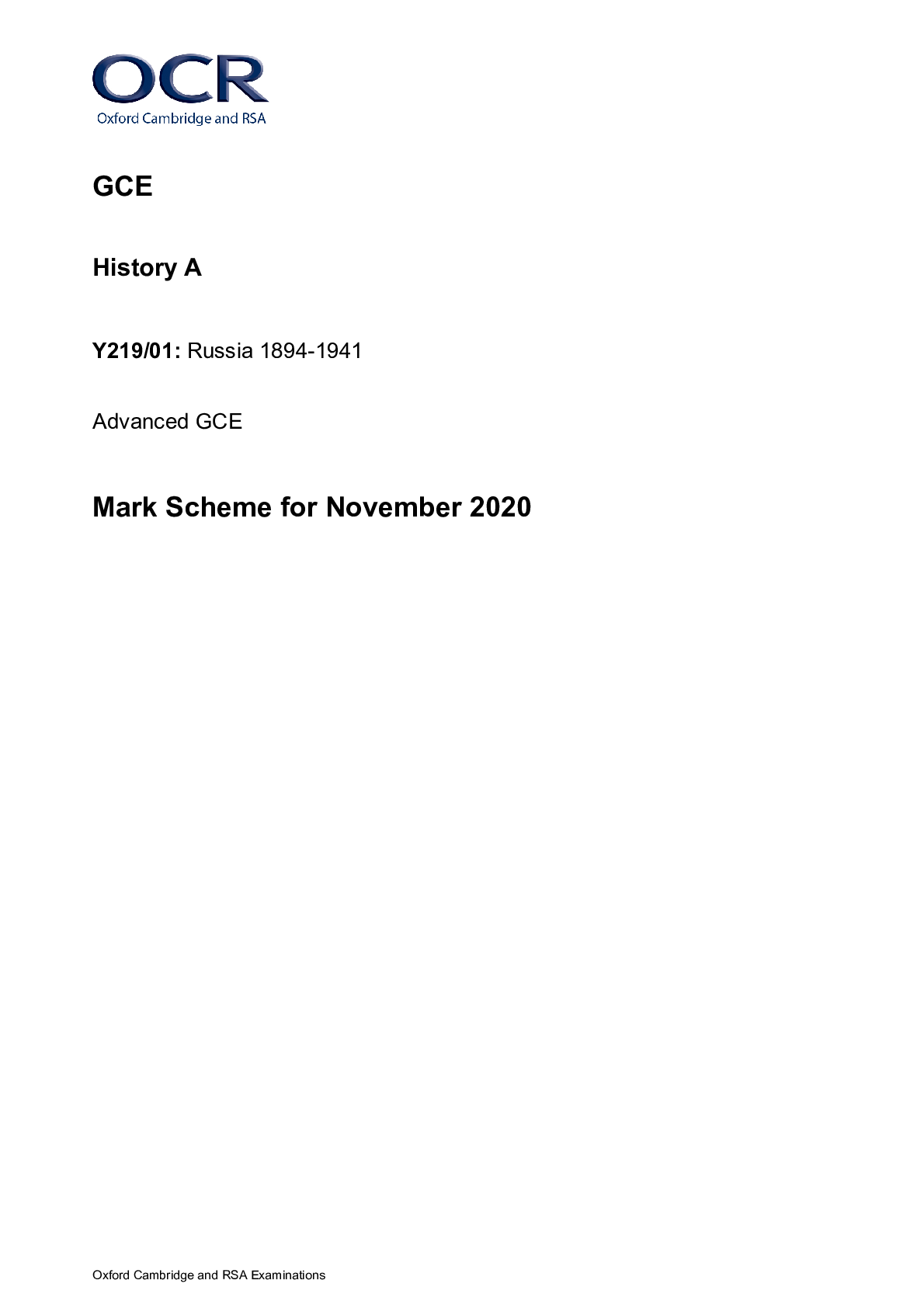
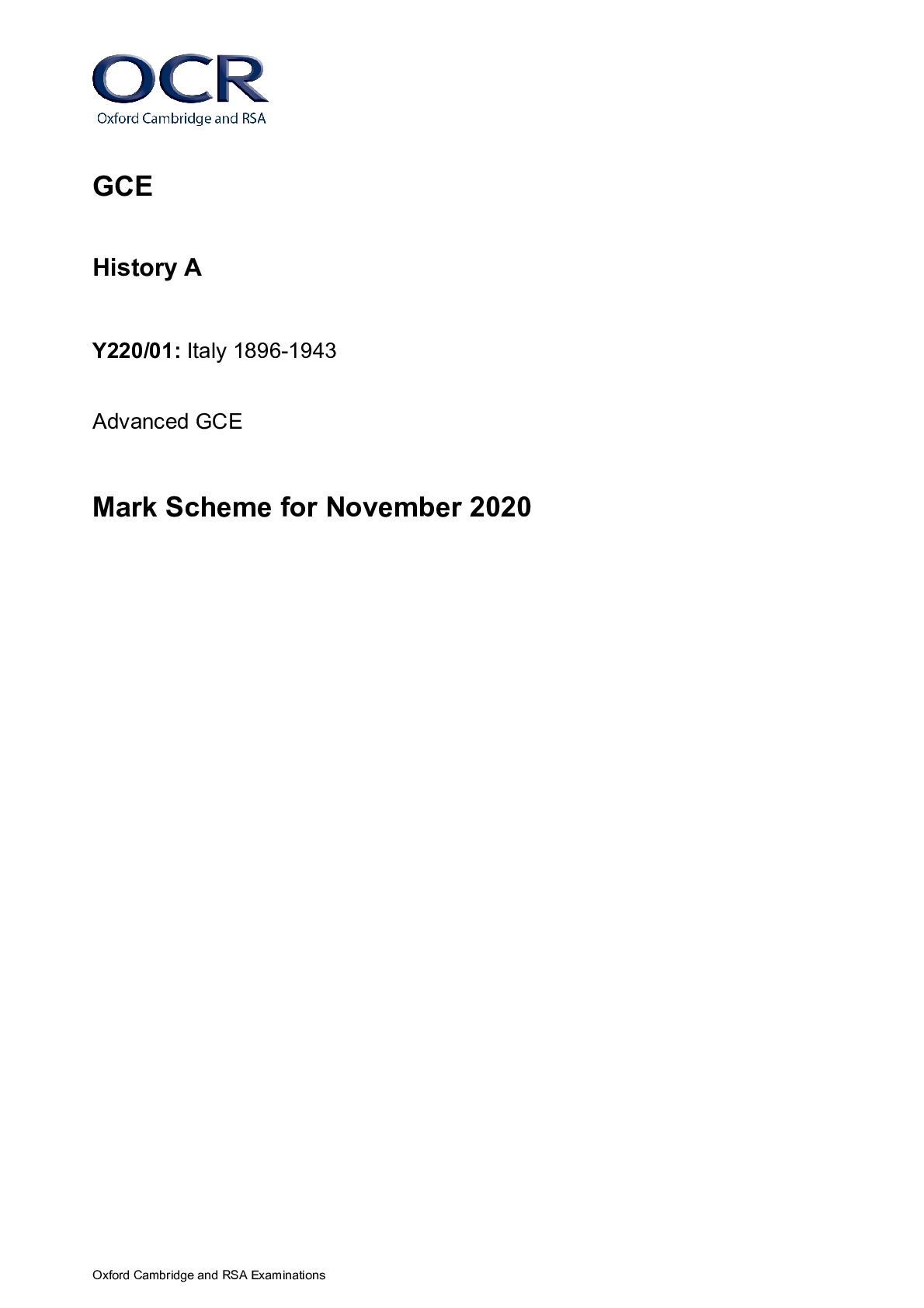

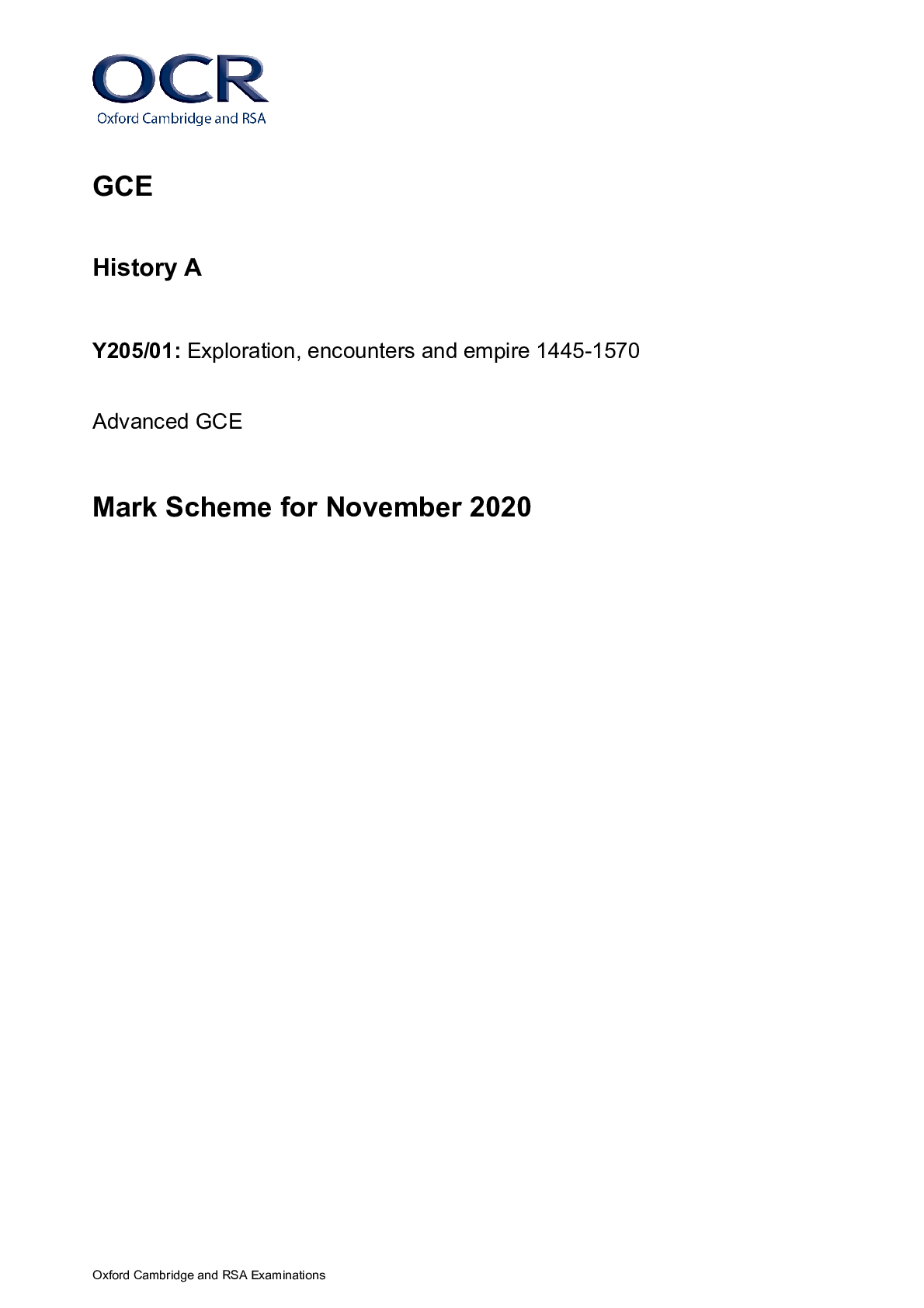
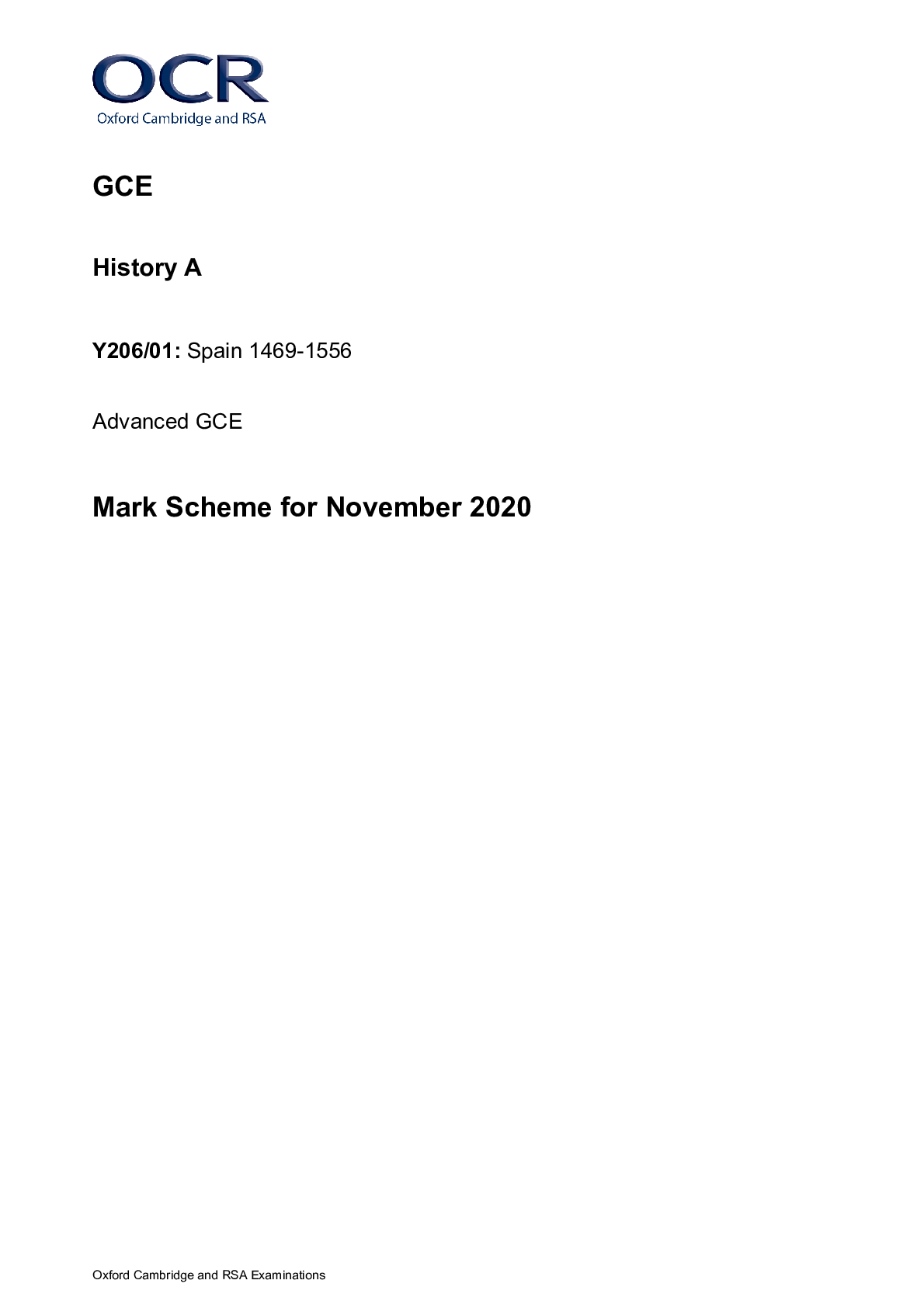
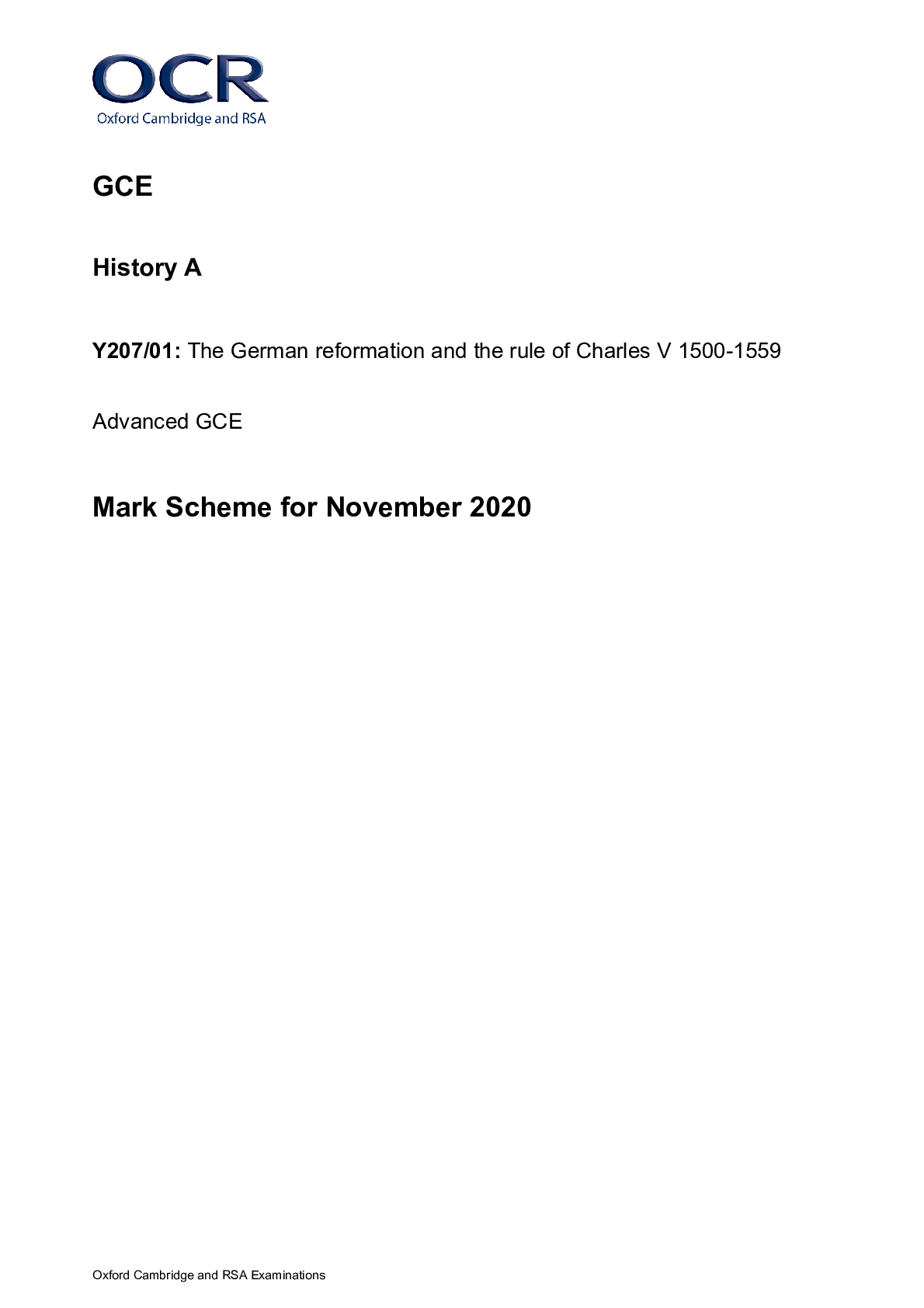
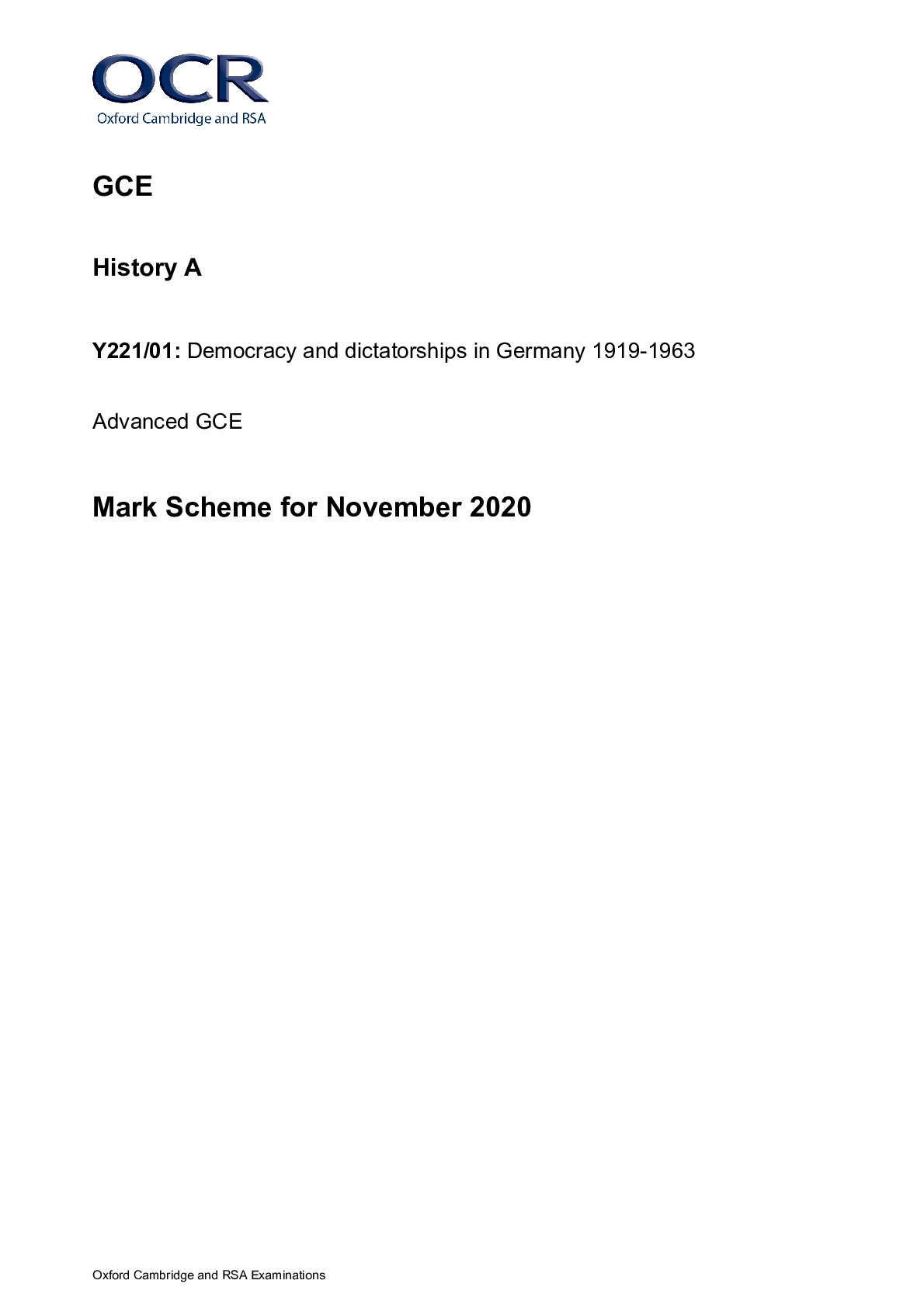

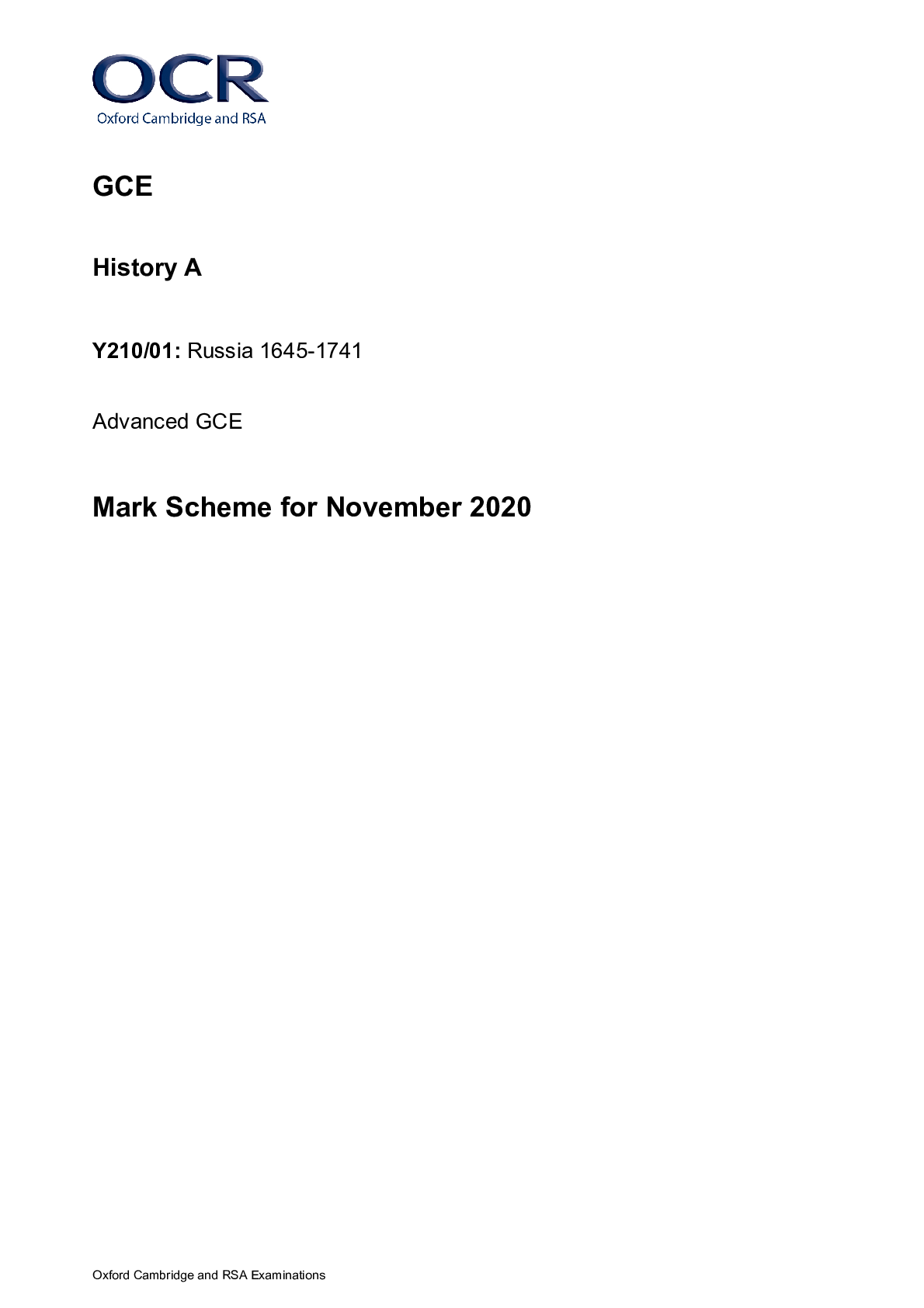
.png)


